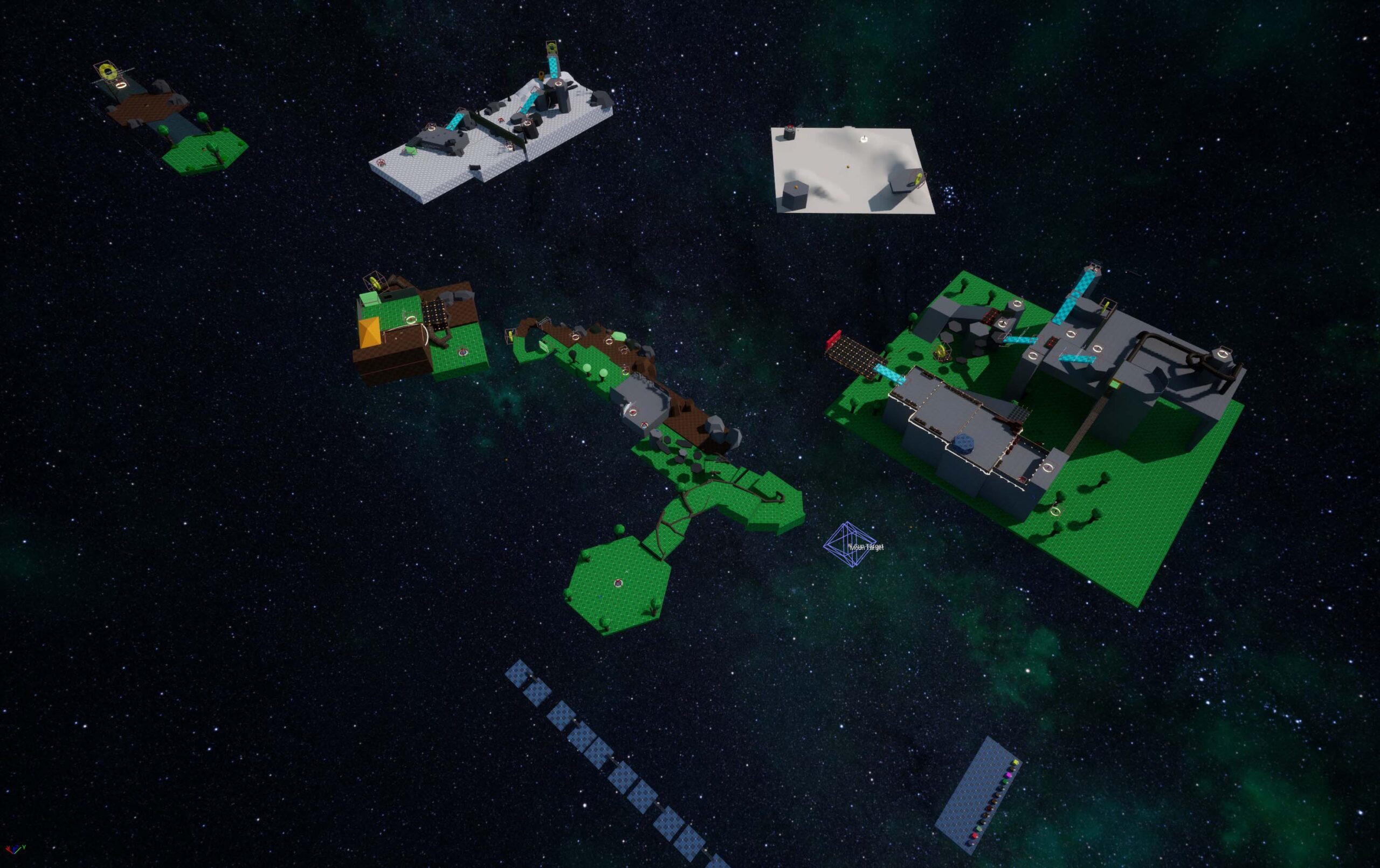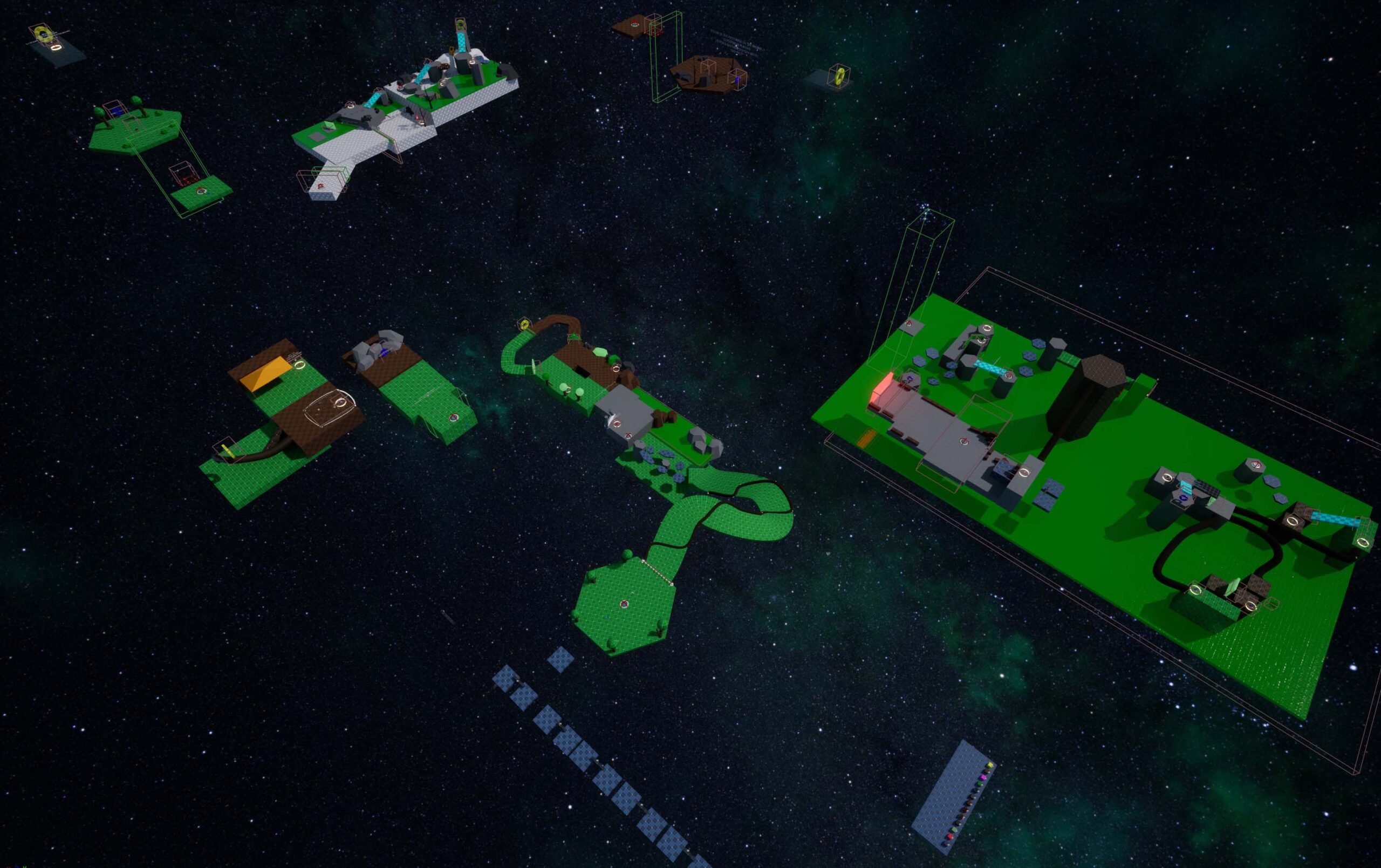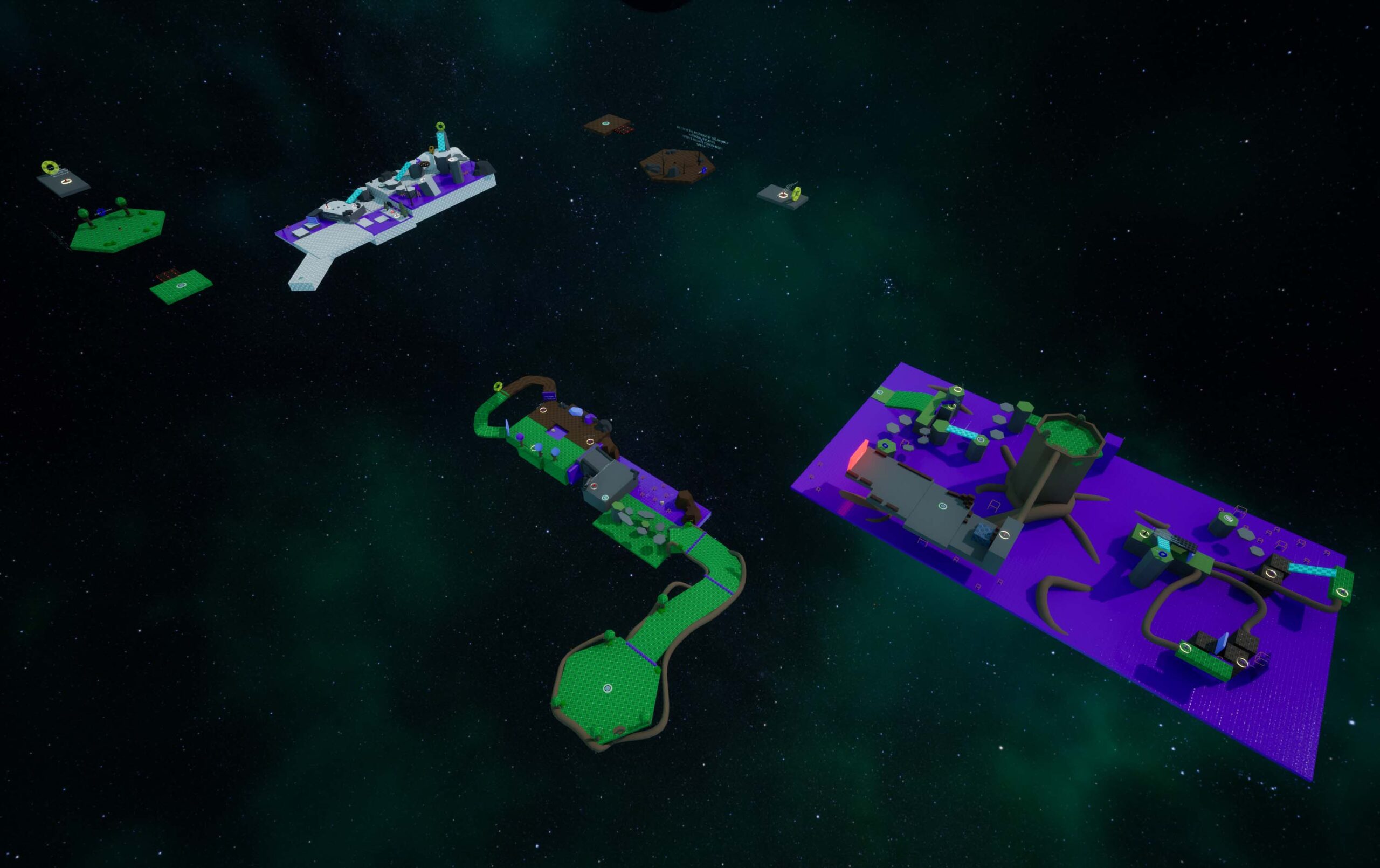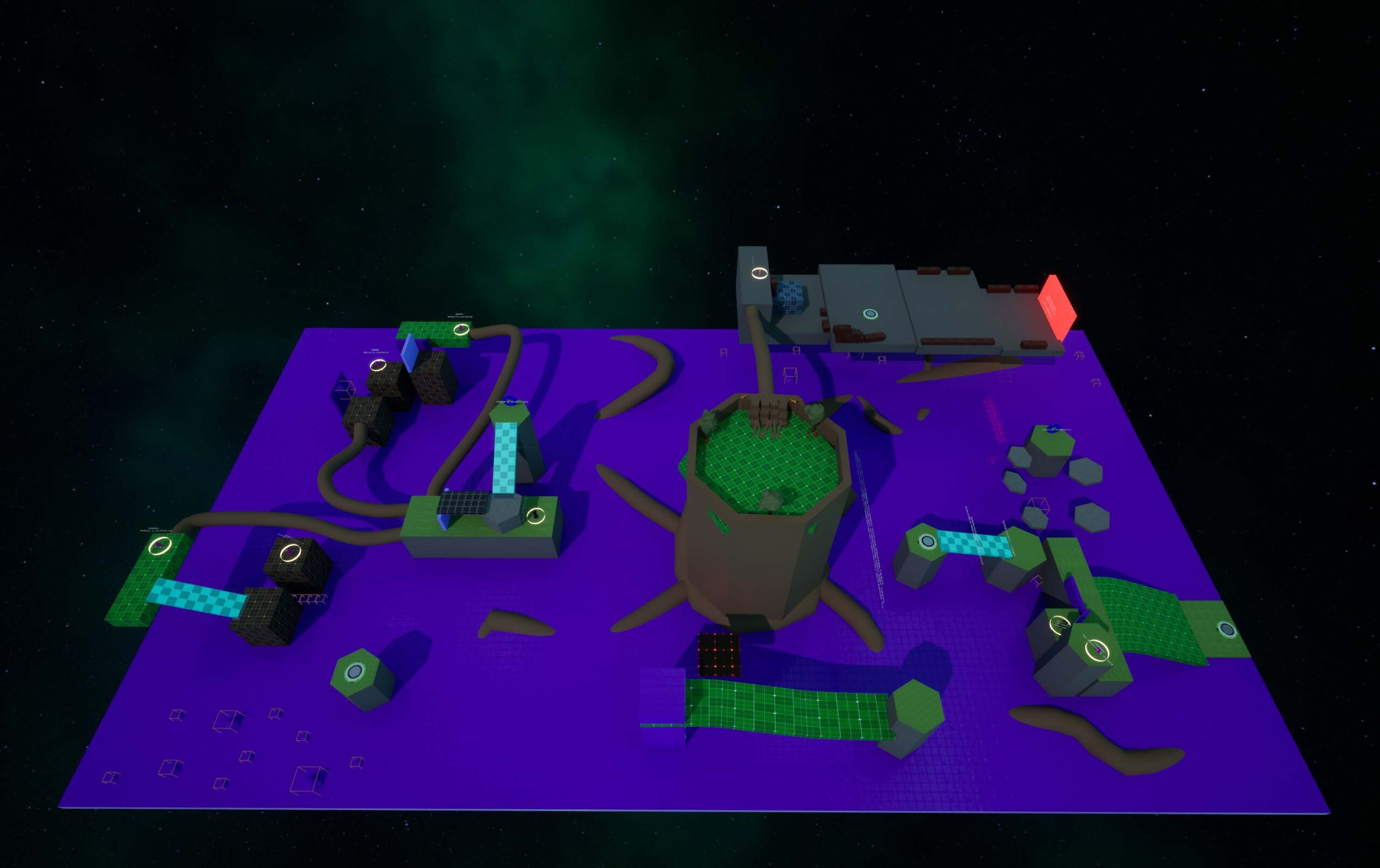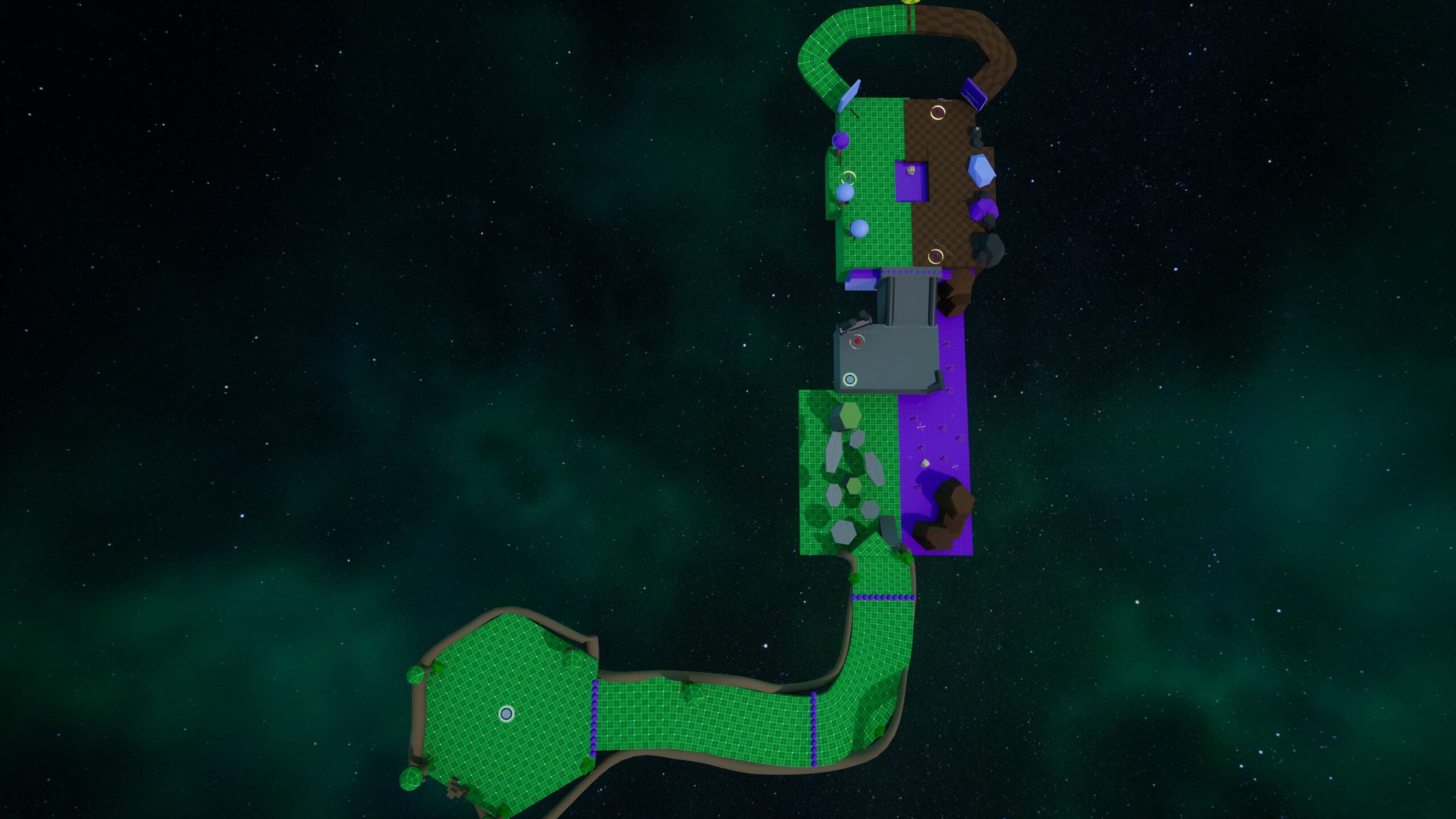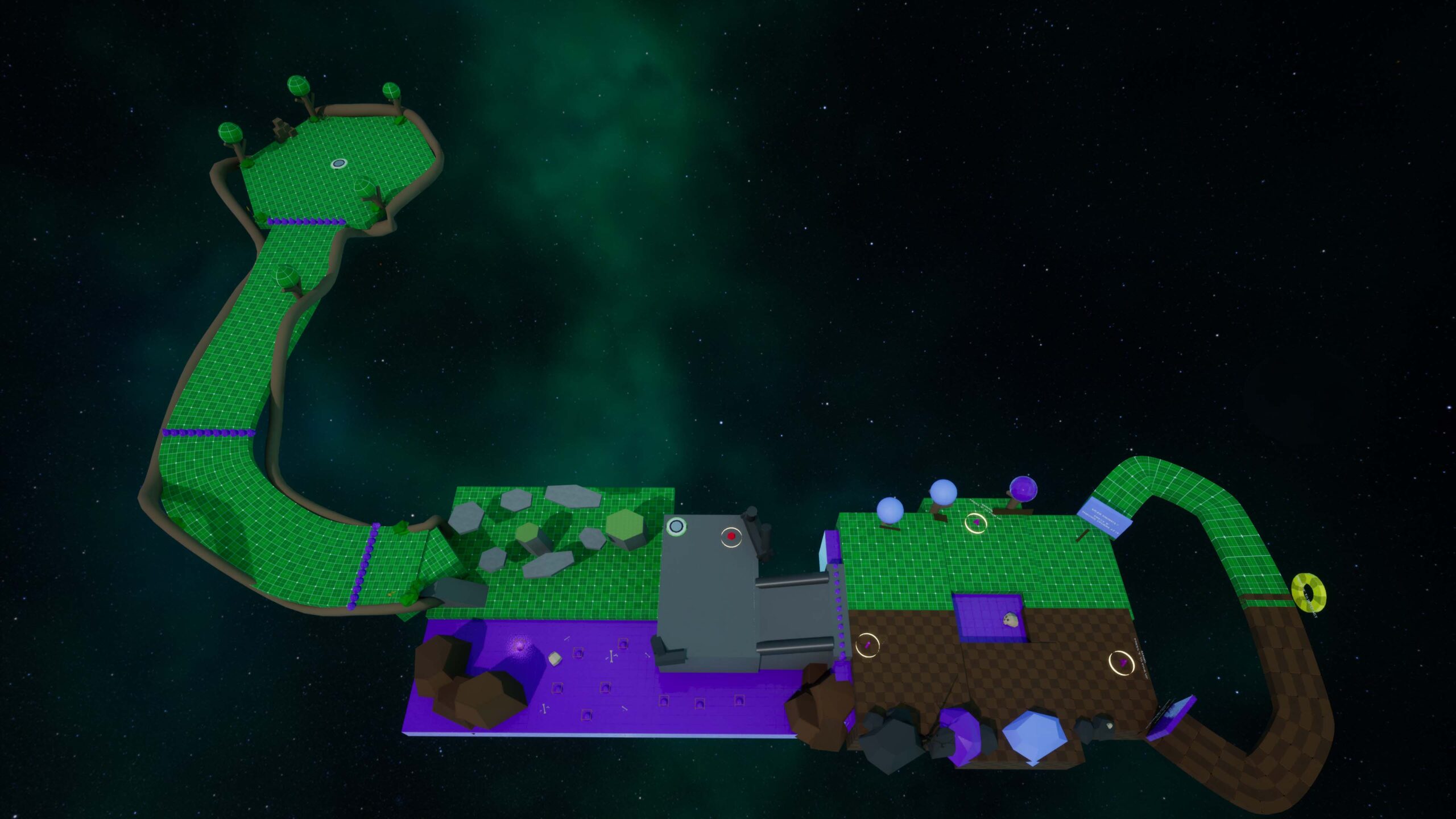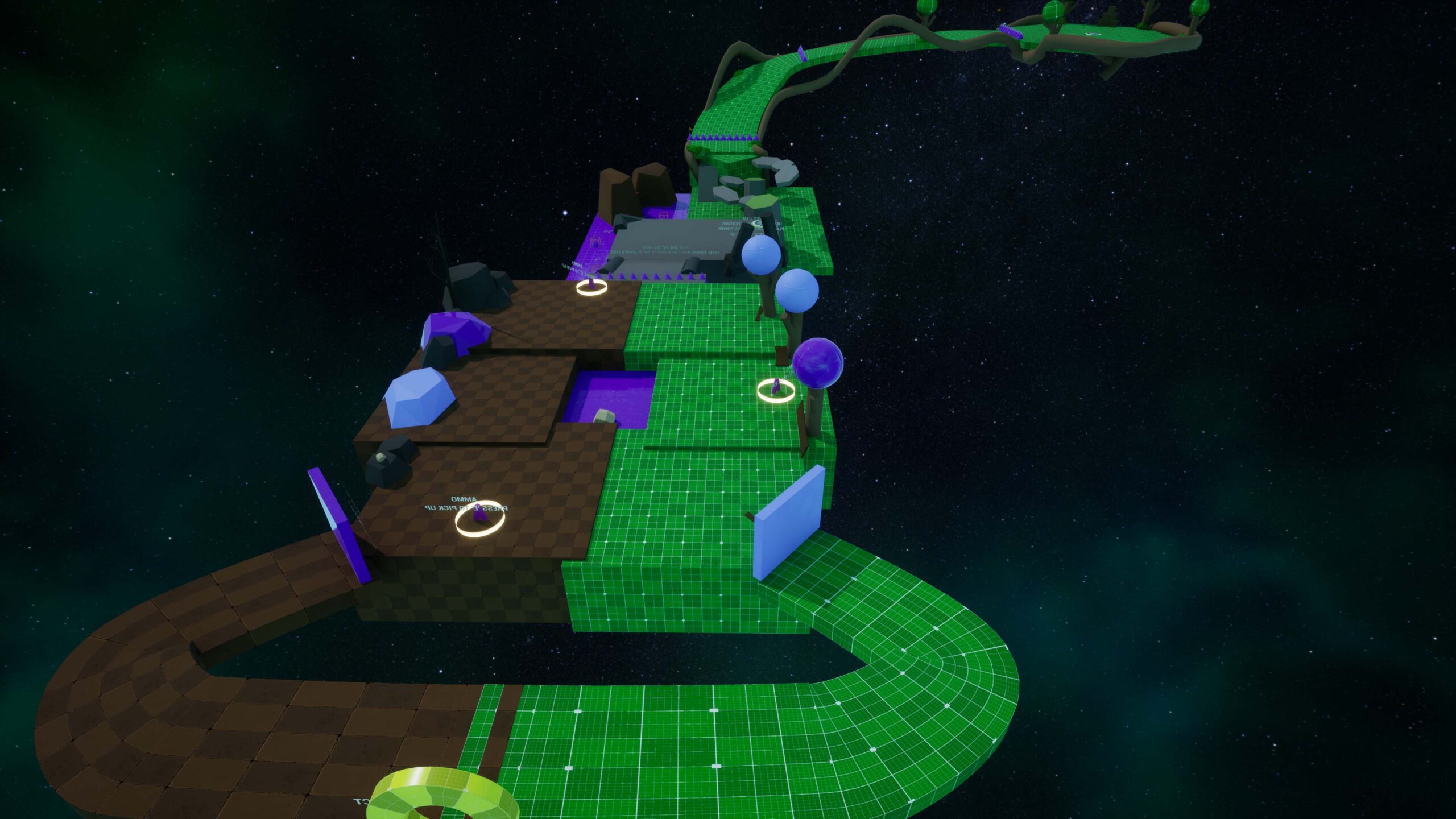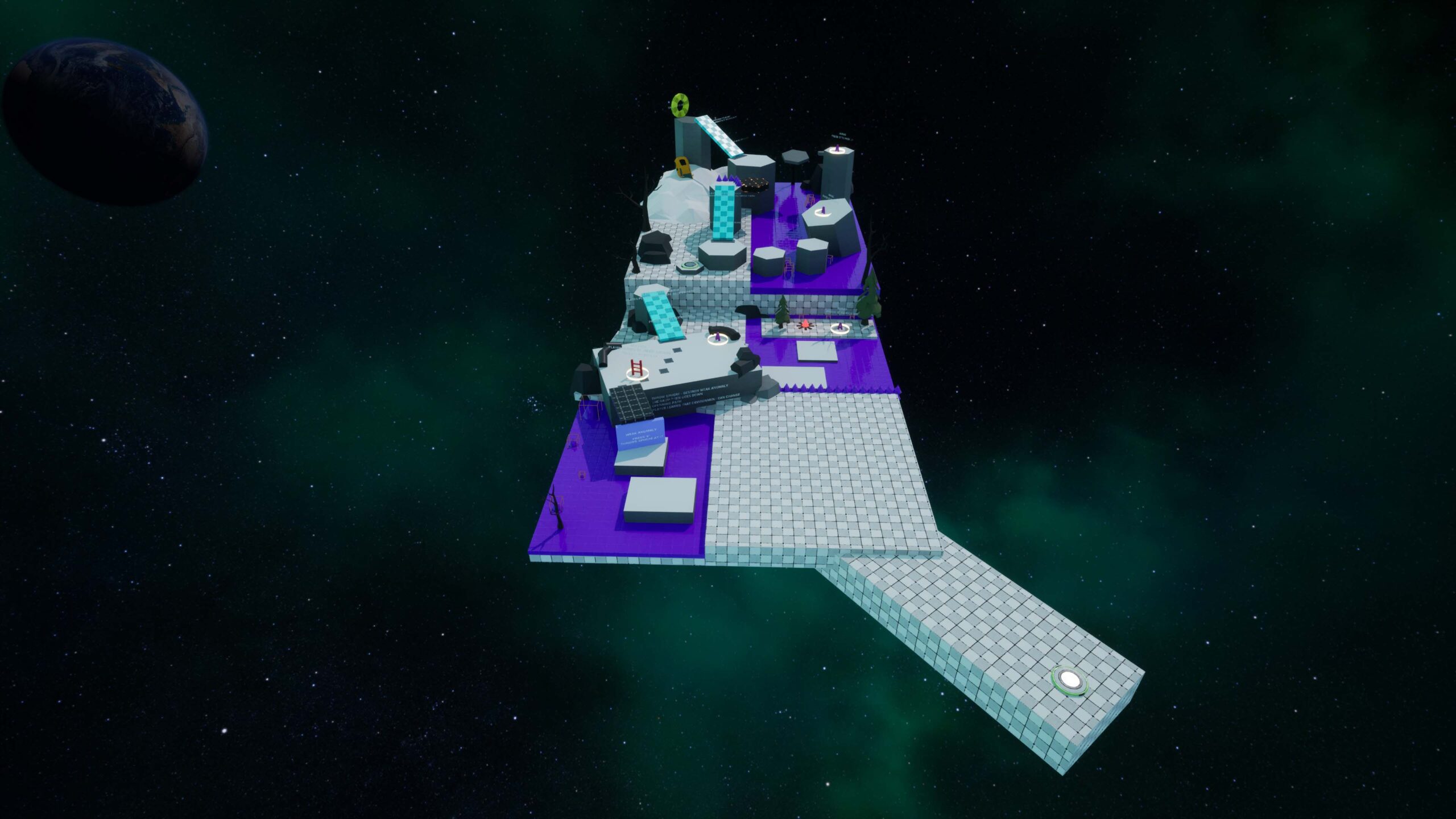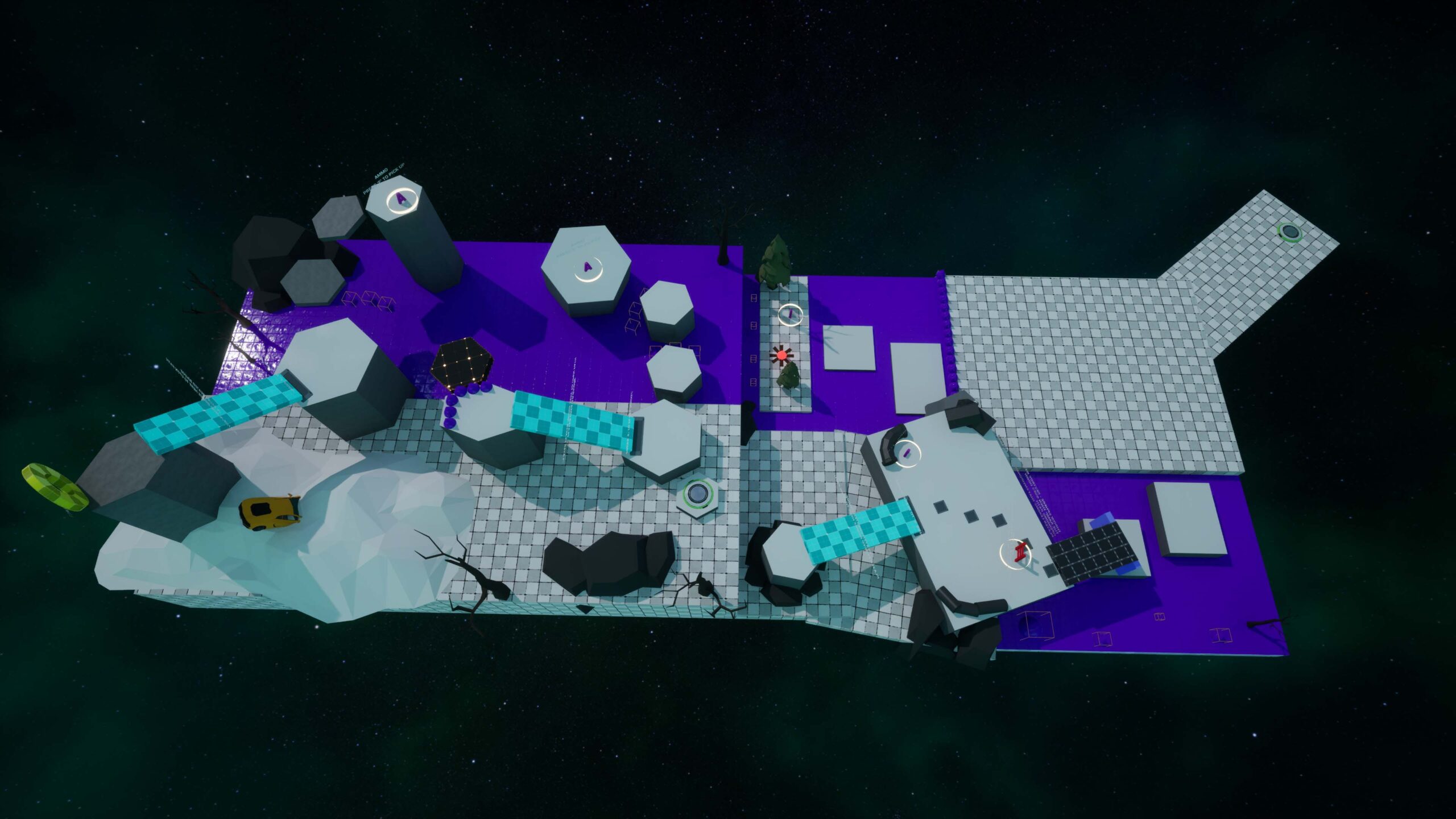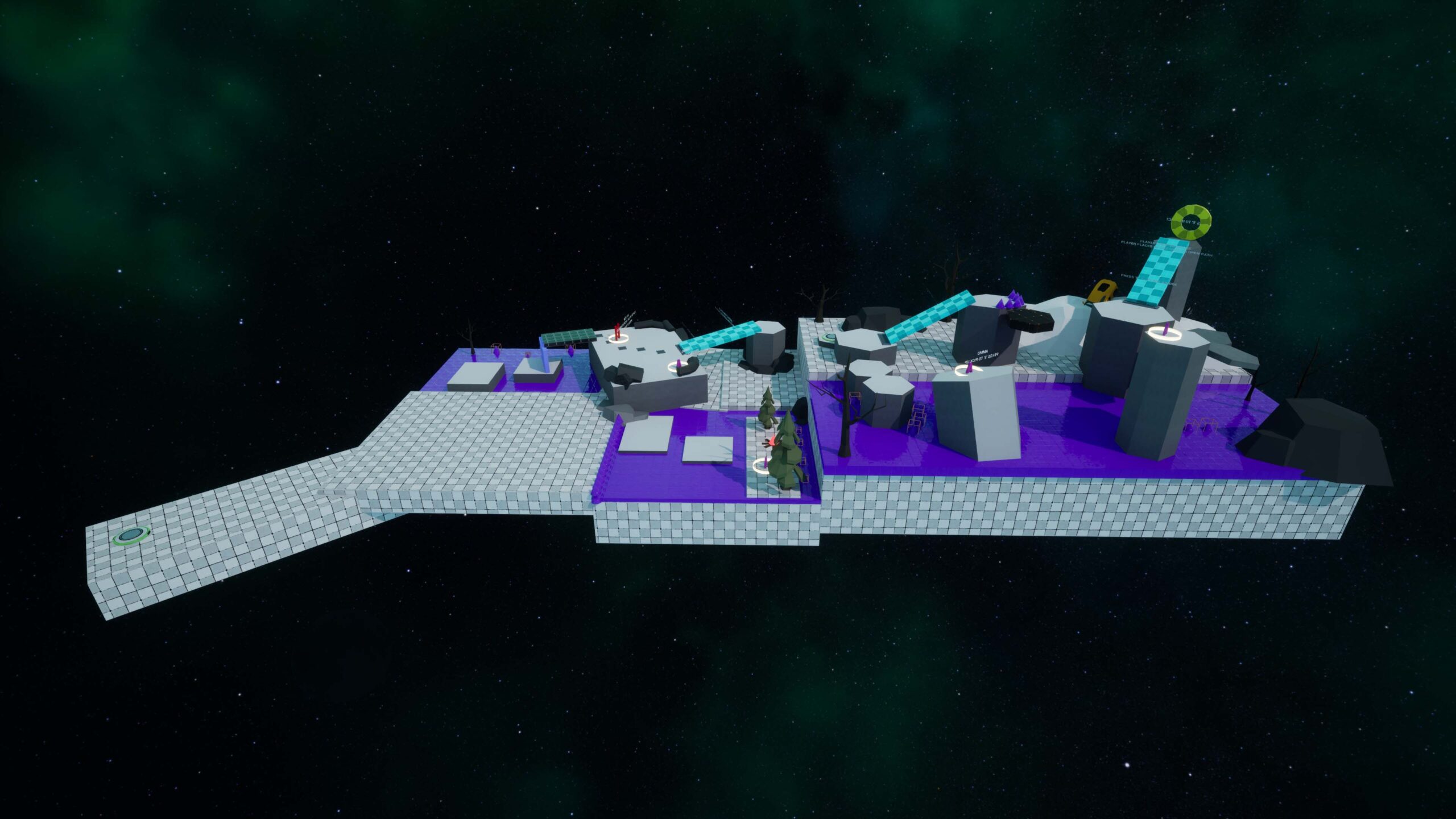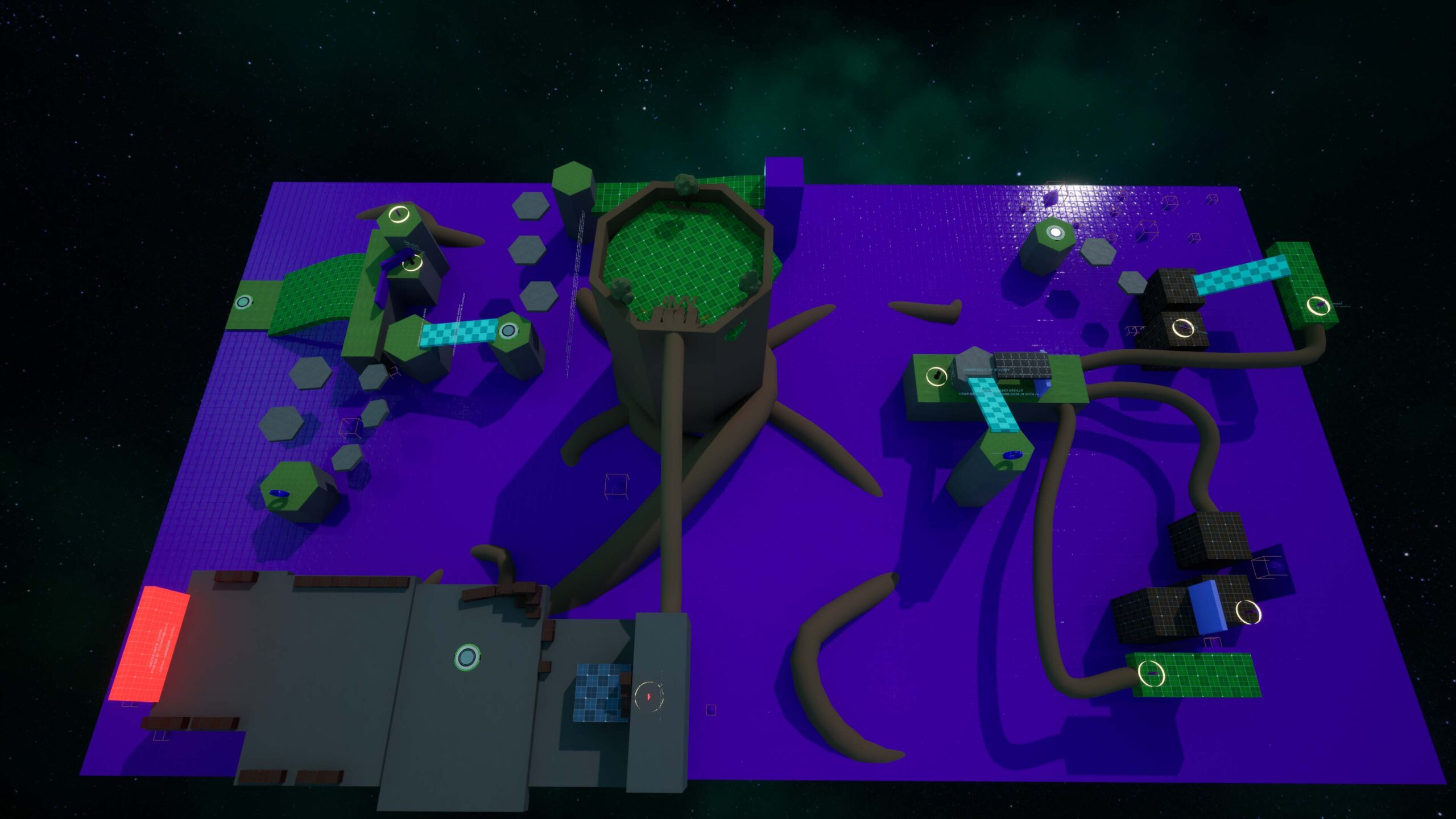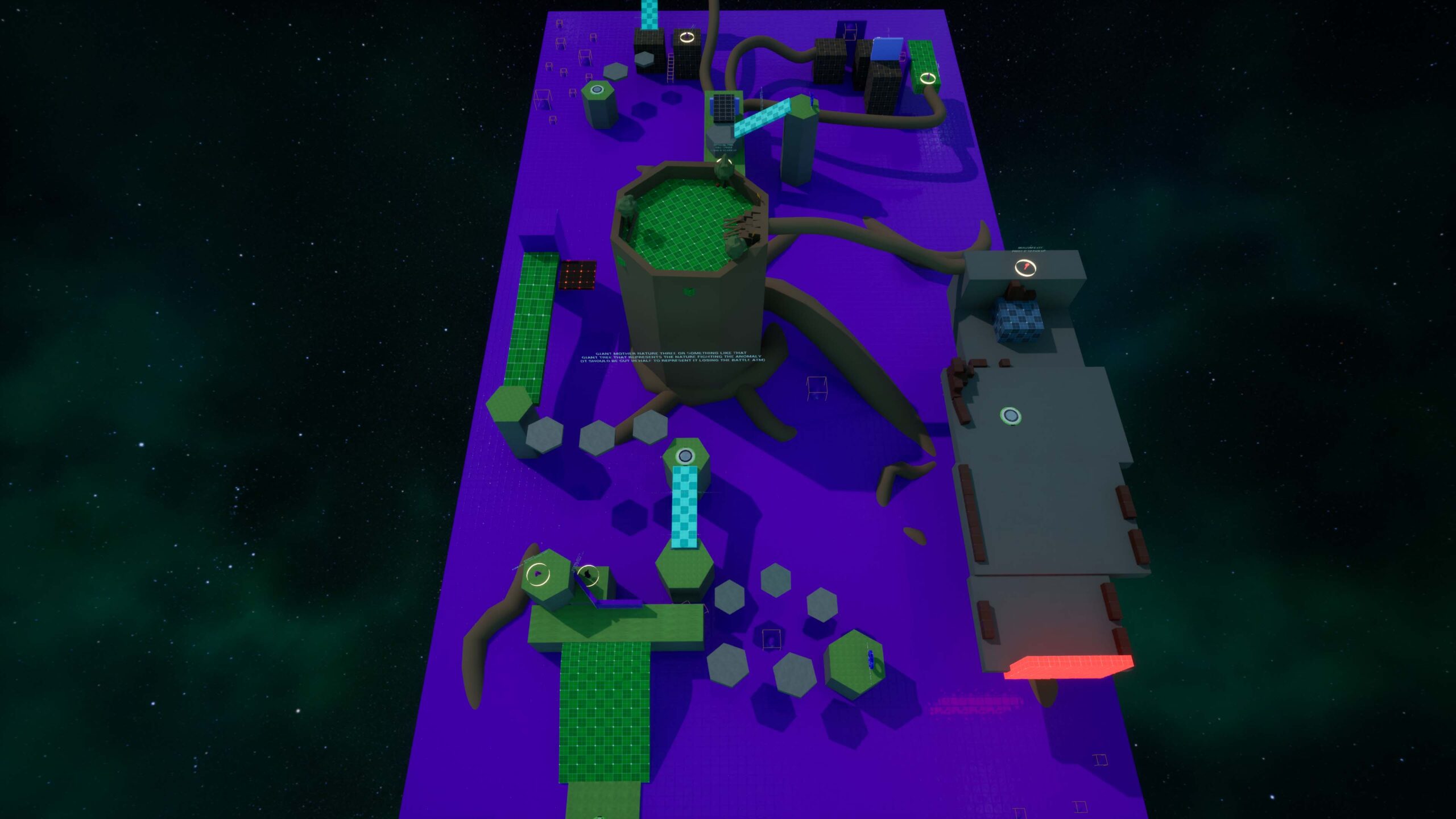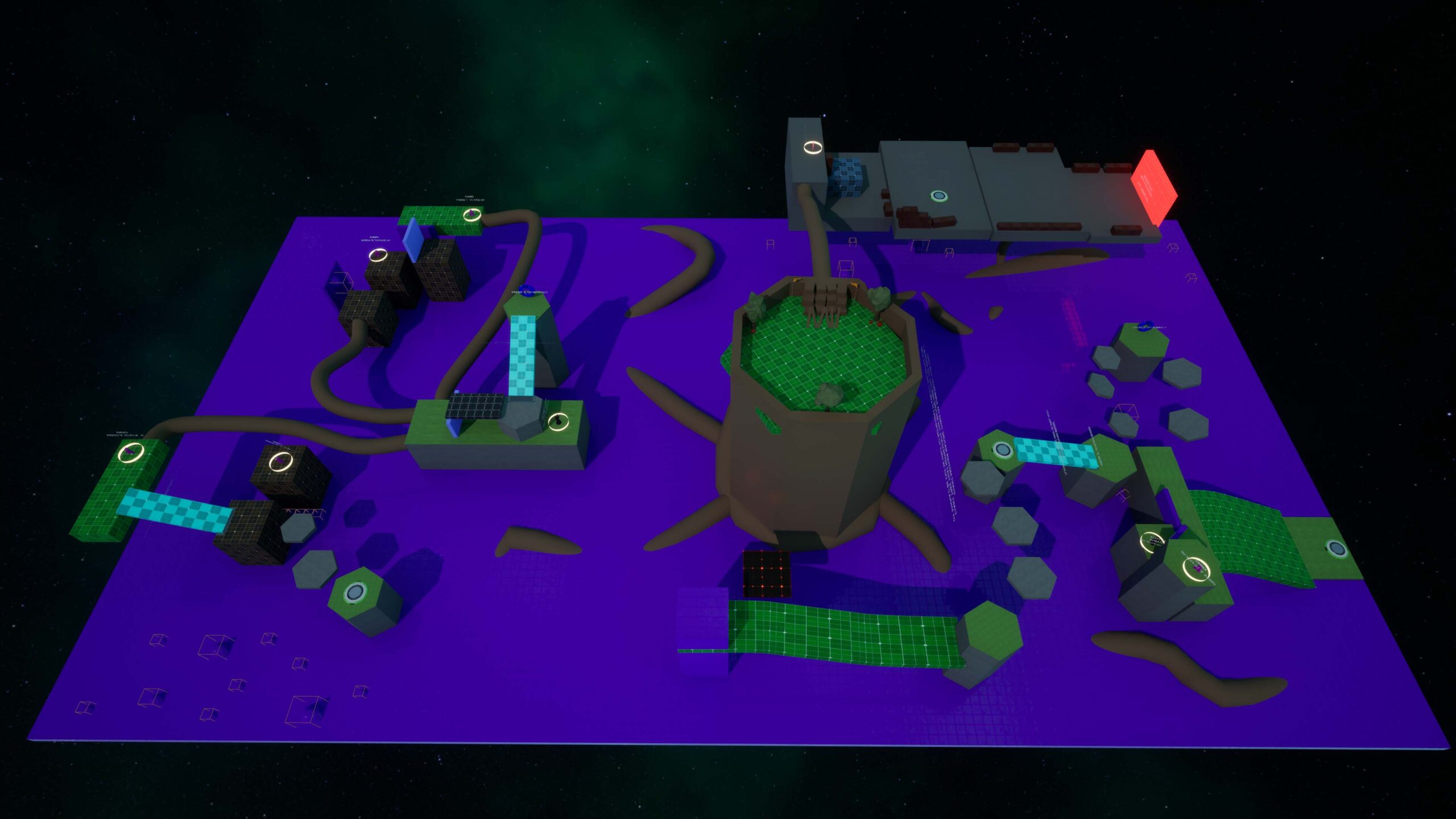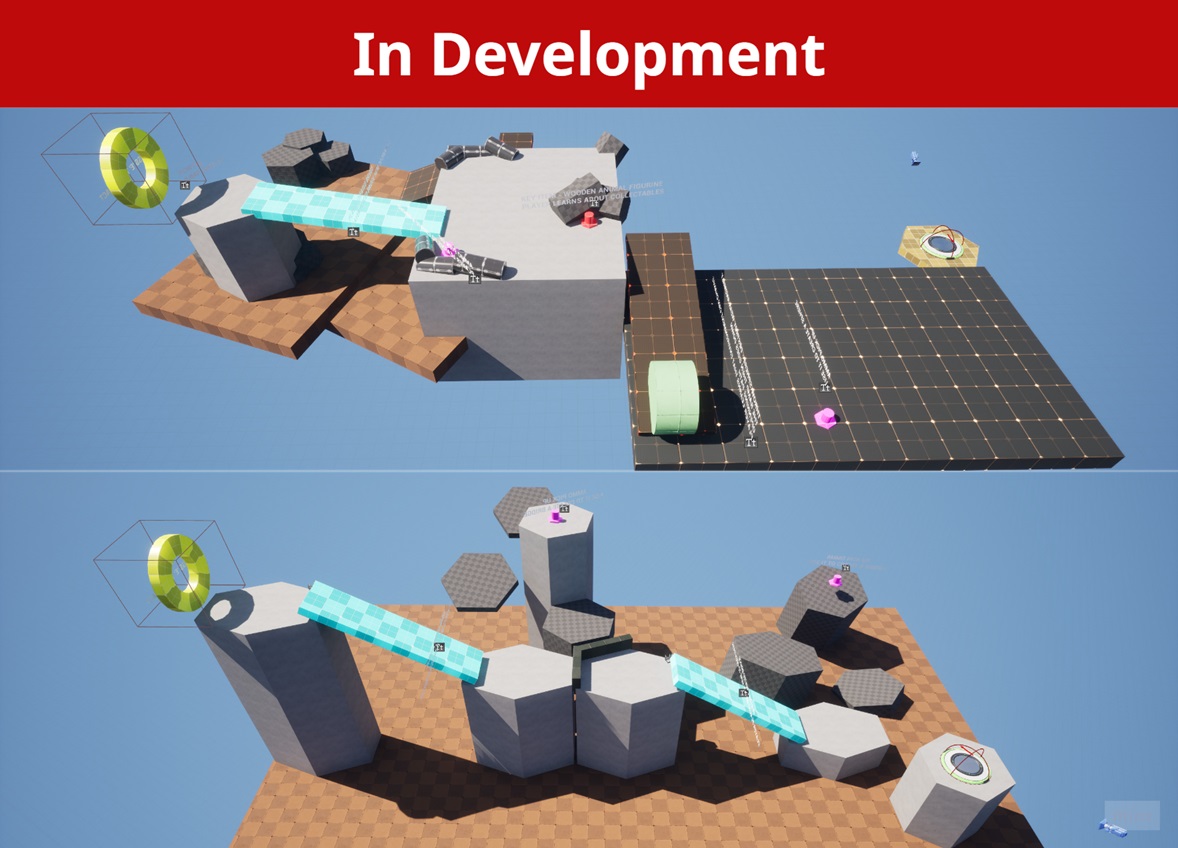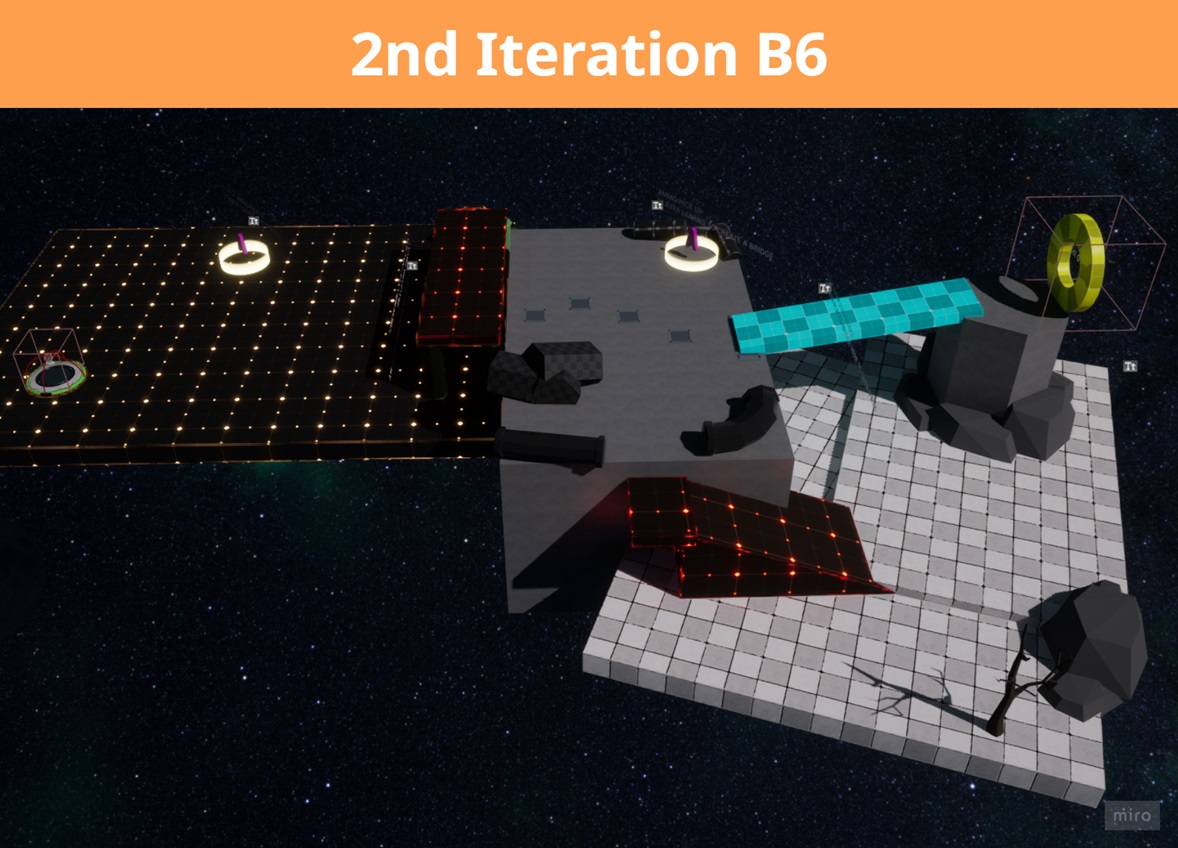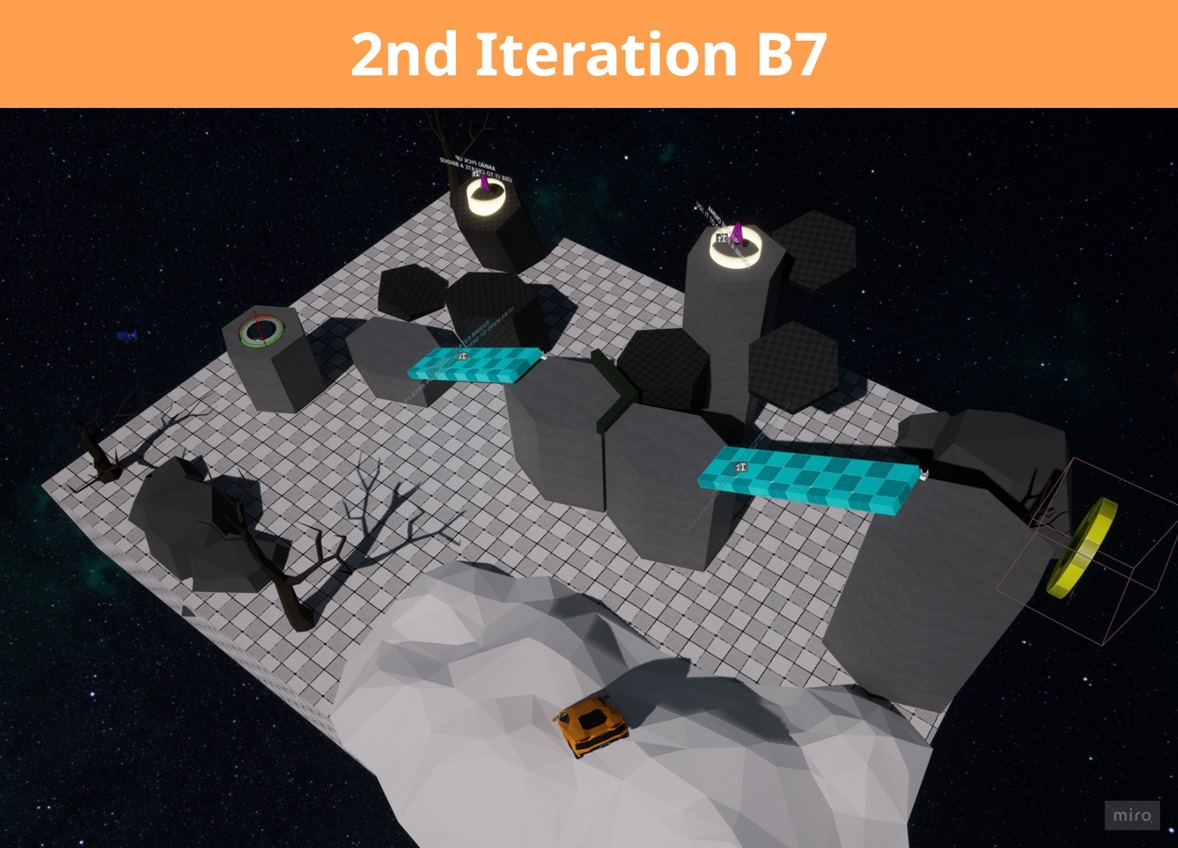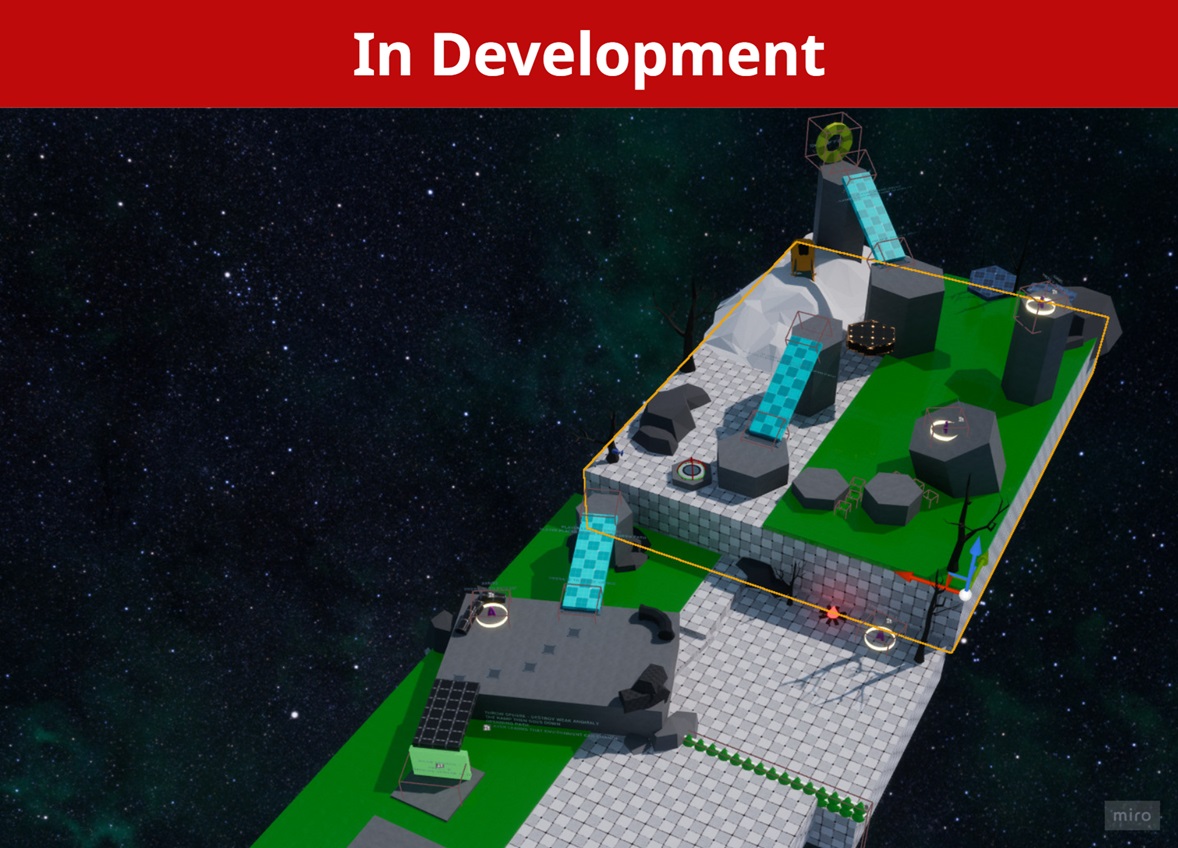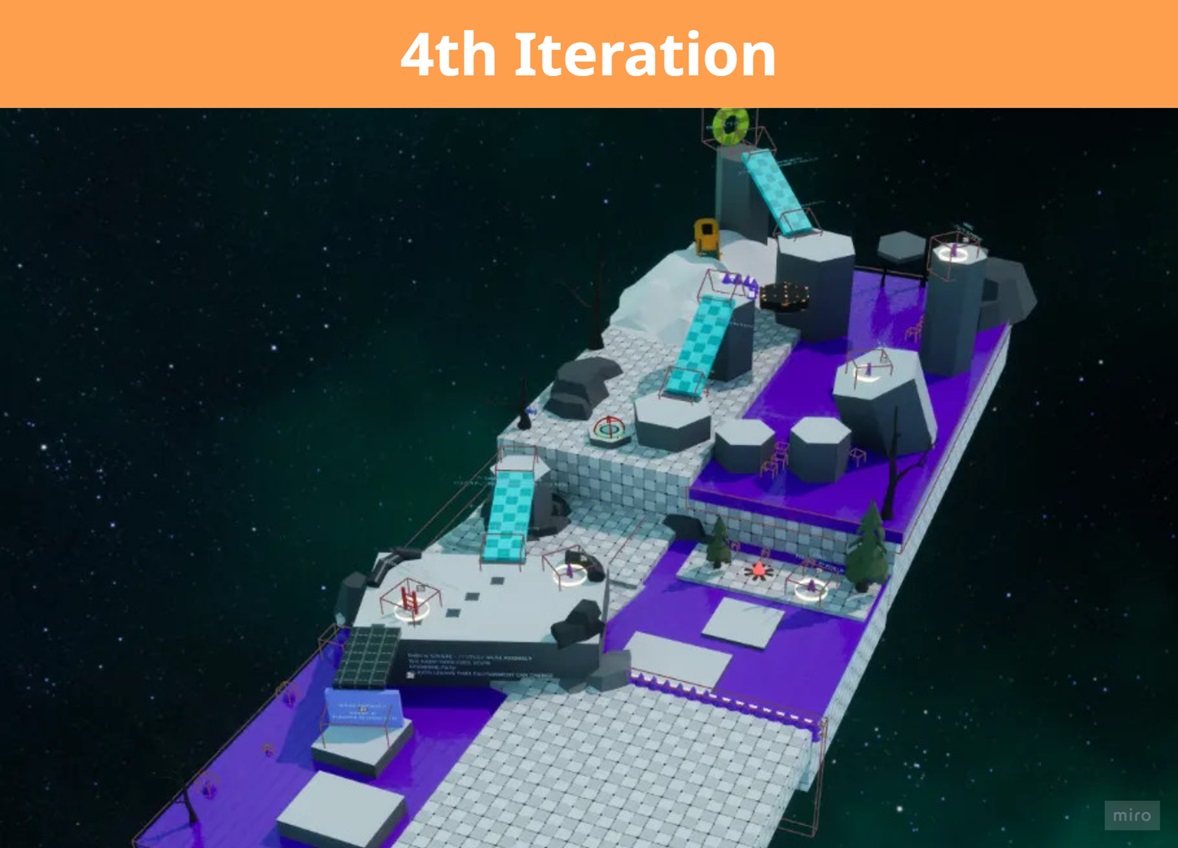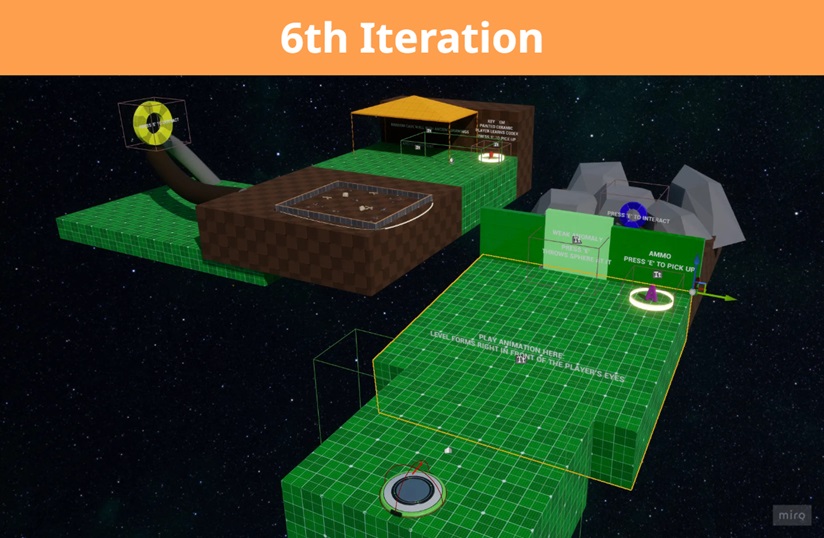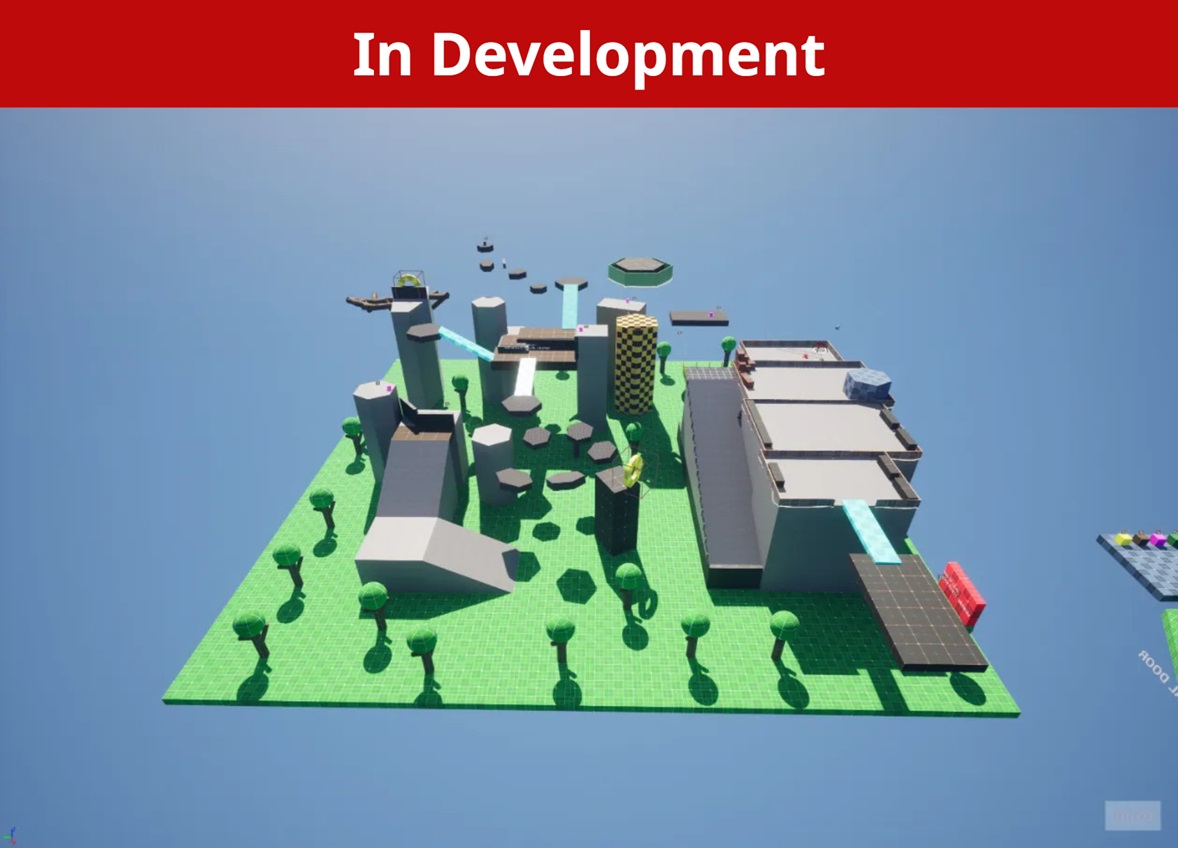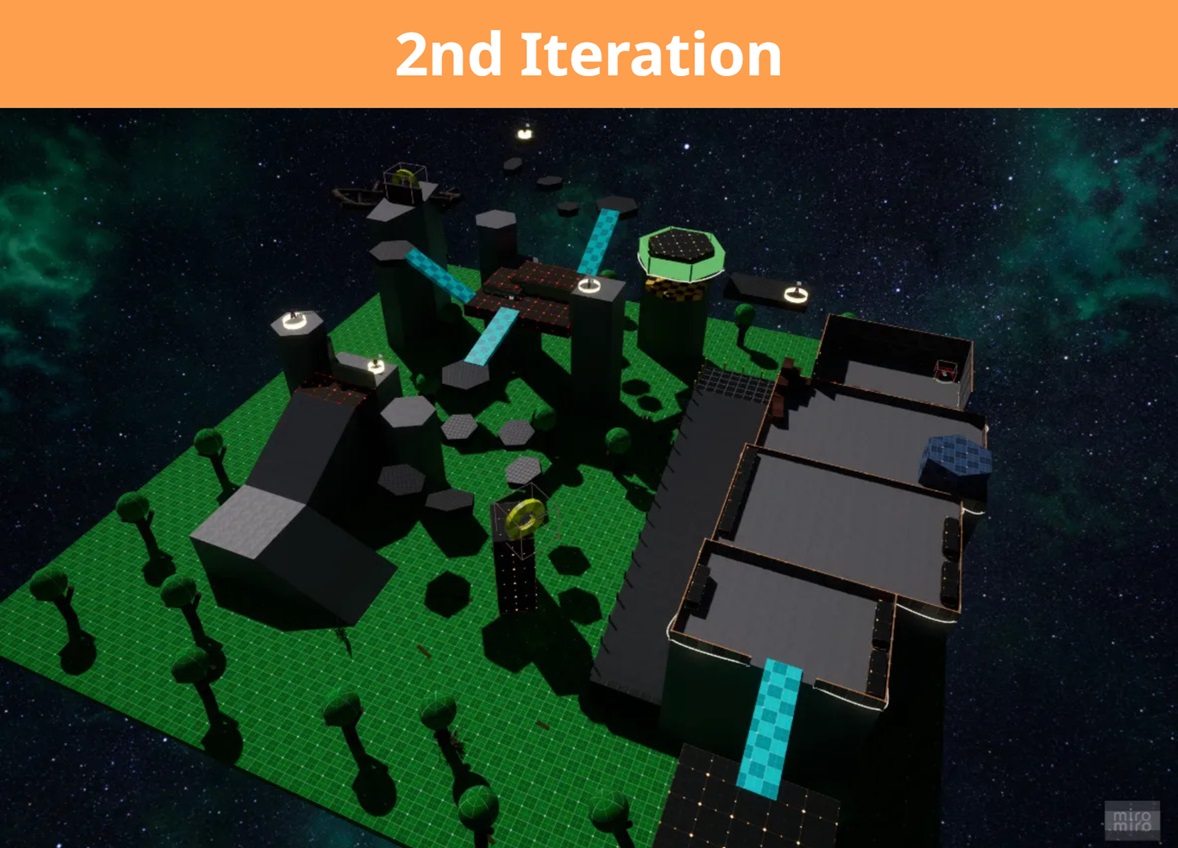Project: Witchwoven
- Genre: 3D Platform Adventure
- Type: Blockout
- Engine: Unreal Engine 5
- Tools: StackOBot, UltraDynamicSky, UE Blueprints, POLYGON – Prototype Pack, SuperGrid, Stylized Provencal
- Iterations # 6
- Playtests # 6
- Role: Level Designer
Goal
Inspired by platformers like Mario 64 and Astro Bot, I designed this level to blend classic 3D platforming adventure genre inspired by Brazilian local culture history.
- Create an engaging 3D platforming experience.
- Showcase local cultural heritage through environmental storytelling.
- Integrate folklore/culture elements naturally into gameplay mechanics.
Through this project, I leveled up my skills in guiding player emotion and discovery via iterative design. Seeking mentorship through Game Design Skills helped me refine mechanics, pacing, and narrative integration, elevating my craft while staying true to the playful spirit of the genre.
Progress
Overview
Setting: The player is trapped in the Void by an anomaly and searches for a viable path forward. As the environment shifts dynamically, it reveals the ongoing conflict between the anomaly and nature through storytelling, platforming, and puzzles.
Constraint: This level was built under an eight-week deadline, emphasizing structured decision-making within production constraints.
Design Pillars:
Tutorial Level – Introduces core mechanics naturally through gameplay, without breaking immersion.
Player Creativity – Encourages experimentation and personal solutions within guided challenges.
Lore Integration – Uses environmental storytelling to build emotional connection and world understanding.
Clear Visual Language – Assets communicate danger, goals, and interaction clearly to support intuitive navigation.
Highlights
Narrative Elements
Puzzle Bridge & Hazards
The player uses the bridge-building mechanic to navigate the puzzle and dodge hazards towards the Yellow Portal.
- Combines environmental threats (hazards), constant visual goals (yellow portal), and a new puzzle mechanic (bridge) to keep players focused, motivated, and engaged throughout the experience.
Reactive World Events
Reactive world events visualize the anomaly-nature conflict during progression, with environmental reactions aiding or blocking the player’s path.
- Enhances immersion and boosts engagement: Helps players feel more connected to a living, responsive world while keeping them interested with fresh, dynamic gameplay moments.
Techniques
Vantage Point: Roof
Players spot the portals, ammo, and goal from above, supporting puzzle clarity and flow.
Navigation: Helps players find their way
Objectives: Points out important goals naturally
Clarity: Makes the layout easier to understand through a full puzzle overviewv
Affordance
I used visual consistency and spacing to make jumps feel intuitive, keeping the affordance reliable in a chaotic setting for the player.
Affordance: Even in chaotic environments, gameplay clarity takes priority.
Consistency: Uniform jump distances and other hidden rules help reduce player frustration.
Balance feel and function: Let the environment feel unpredictable, but function with clear, logical rules.
Safety Net
To aid learning, I used safety nets instead of fatal drops, letting players recover without restarting.
Reduces Frustration: Prevents restart loops, maintaining enjoyment.
Supports Learning: Encourages mechanic learning without punishing mistakes.
Builds Confidence: Strengthens skills gradually before raising difficulty.
Level Streaming
Full visibility broke pacing and story flow, so I used a trigger-based system to guide the player.
Reduces visual overload: Players can focus on immediate goals without feeling overwhelmed.
Enhances immersion: The world feels alive and responsive, building as the player progresses.
Supports narrative clarity: Reinforces the theme of a shifting, unstable reality
Walkthrough
Beat 1: Openning Scene
The initial cutscene introduces the player to the world, showing them being swallowed by the anomaly, thrown into the void, saved by the necklace, and placed on the game’s starting platform.
Gameplay Type: Narrative
Beat 2: Basic Movement
The game’s starting platform introduces basic movement mechanics through a sequence of small jumps the player must complete.
Gameplay Type: Tutorial / Light Narrative
Beat 3: Weaving Power
A cutscene would show the player acquiring the Headdress and introduces the Straw Weaving mechanic, marking the first power unlock.
Gameplay Type: Light Narrative / Straw Weaving Power Introduction
Beat 4: Weaving Power
The player learns to use the basic Straw Weaving mechanic by collecting ammunition and crafting items. Strong and Weak anomalies are introduced, with players able to destroy Weak anomalies using crafted spheres. Environmental storytelling begins to show the conflict between anomaly and nature, setting the tone for the world. The section concludes with the discovery of a portal leading to the next area.
Gameplay Type: Weaving Mechanic & Portal Tutorial
Beat 5: Lore
The player interacts with a cutscene depicting a moment from a happier past, then learns to use the blue portal mechanic. The section ends with the player’s first interaction with a painted ceramic, introducing the Codex system for lore discovery.
Gameplay Type: Tutorial Lore / Tutorial Blue Portal
Beat 6: Bridge Power
The player reaches a new junkyard area covered in snow and must complete a challenge to unlock the bridge-building ability, allowing them to connect distant points in the environment.
Gameplay Type: Bridge Tutorial
Beat 7: Hazards
The player must solve a puzzle while navigating newly introduced environmental hazards, learning to balance movement, timing, and observation under threat.
Gameplay Type: Hazard Tutorial
Beat 8: Lore 02
The player interacts with a cutscene revealing a moment from a sad past, followed by a refresher on the blue portal mechanic. The section concludes with the first interaction with a Wooden Animal Figurine, introducing the Collectables system.
Gameplay Type: Narrative / Tutorial Collectable
Beat 9: Roof Seq.
The player reaches the museum door but discovers it is locked. A cutscene reveals the key spawning behind them, and when attempting to retrieve it, a water box activates, trapping the player and transporting them to the final puzzle.
Gameplay Type: Traversal / Narrative
Beat 10: Final Puzzle
The player must combine everything learned about the Weaving mechanic to solve the final puzzle of the level, ultimately reaching the museum key needed to unlock the door and complete the stage.
Gameplay Type: Traversal & Puzzle Challenge
Research & Documentation
Research, ideation and planning
As part of the pre-production phase of this project, all research and conceptual materials were organized in a dedicated Miroboard. The board provides a detailed overview of the creative process and includes:
The initial concept for the game (beyond just the level).
An analysis of three games as object reference.
Visual research of real-world objects.
Reference gathering from other media forms (film/animation).
The research, ideation, and final synthesis shaped the level’s initial idea.
As a result, the research, ideation, and synthesis conducted directly informed the structure of the level’s narrative, pacing, and core gameplay systems.
Level Design Document
This LDD was created in two stages: one pre-production, and one revised after the final blockout. Adapted from Jordan Mcmorris’s template (with permission), it includes full design details of elements like narrative, mechanics, pacing, and layout, and it is available in Notion’s page below.
Iterative Development
Example 01: Snow Zone (Beat 06 & 07)
Result
Initially designed for platforming and bridge tutorials, the Snow Zone changed during development:
Hazard elements were added to the environment.
The setting was reimagined as a snowy junkyard.
The zone reflects environmental impact caused by the anomaly.
First & Second Iteration
Beat 6 and Beat 7 were initially structured to deepen engagement with platforming and bridge mechanics:
Reinforce movement skills
Introduce bridge ability in practice
Changes to the level’s metrics prompted a redesign of Beat 7.
Solution:
The redesign emphasized:
Reduced redundancy
Alternative paths for recovery
Early integration of mechanics appearing in later gameplay
Results:
Mechanics loop back into later beats
Layout matches updated pacing expectations
Third & Fourth Iteration
Player’s test indicated that the main path was too narrow and rigid. To improve flexibility, I expanded the playable area during iteration 3 and 4.
Merge B7 and B8 into a single larger space.
During the fourth iteration, a playtest revealed pacing and clarity issues.
Problems:
Confusion around bridge mechanics
Idle time between gameplay points
Lack of environmental threats
Solution:
Reintroduced a key item for bridge creation
Tightened space between gameplay moments
Added environmental hazards
Example 02: The Decision to Cut "B5"
Result
No players or instructors, despite having followed the level’s development for eight weeks, noticed that the entire zone had been removed. This confirmed that B5 wasn’t essential to the game’s experience.
After seven unsuccessful iterations, cutting B5 turned out to be the most elegant and effective solution. What was lost in repetition was gained in pacing and clarity.
Sometimes, the best design choice is knowing when to let go. Here is why.
Original Intent:
Reinforce the use of the sphere to destroy weak anomalies. That was its sole purpose during the first iteration.
Observed Issues:
The zone felt small and repetitive.
It failed to meaningfully connect the interaction between weak and strong anomalies.
Iteration 2&3:
Added a Lore spot and introduced the concept of walking on tree roots. Redesigned the zone as an archaeological dig site, connecting it to the idea of painted ceramics that deliver Lore.
Problem:
The purpose of the Lore spot wasn’t clear to players.
Despite conceptual improvement, players still wandered without clear purpose.
The zone failed to communicate its objective effectively.
Multiple Iterations Later:
I tried:
Reinforcing the weak/strong anomaly mechanic in different ways.
Redesigning the layout.
Teaching the blue portal mechanic.
None of these versions felt like they added meaningful value.
Comparative Analysis:
| 7th Iteration | B6 Final Version |
|---|---|
| Reinforces strong/weak anomaly mechanics | Introduces moving platforms |
| Introduces blue portal (intra-zone teleportation) | Reinforces blue portal |
| Introduces root traversal | Delivers narrative through cutscene |
| Introduces Codex for narrative | Introduces Collectibles and Inspection mechanic |
Rationale for removal:
Content Redistribution:
The Codex system was moved to the end of B6 (after the cutscene), ensuring narrative continuity without requiring a dedicated zone. This change resulted in no loss to core gameplay functionality when implemented properly.
Obsolete Teaching Moments:
Strong/Weak Anomaly Differentiation:
Already reinforced effectively through the color-coded system in B2–B4, making additional repetition unnecessary.Root Navigation:
Introduced naturally in B1/B2, and repeating it in B5 offered little new value to the player experience.Blue Portal Tutorial:
Its introduction can be more effectively handled in B6 or B9 through improved platform layout and clear visual signaling.
Example 03: End of Level Sequence: Beat 09/10/11
Result
Designed as the culmination of the level, the final zone highlights the environmental battle between anomaly and nature, while challenging players with advanced variations of previously learned mechanics.
First & Second Iteration:
General idea:
See the final door (objective)
Understand the need for two ammo and where to use them
Locate both ammo pickups
Feedback:
Excessive backtracking
Poor visual signaling
Objective not visible at a glance
Split-path structure overly complex for an introductory level
Repetitive second puzzle section
Solution
Removed the two-part puzzle to maintain linear flow
Focused the objective on using one ammo to reach the museum door
Reorganized layout and door placement to minimize backtracking
Third Iteration
Feedback:
Risk of soft-lock if the player fell after placing a bridge
No safety nets, unlike previous sections
Poor visibility due to low lighting
Results
The space was redesigned to guide the player more clearly and safely:
Added safety nets to prevent falling to ground level
Introduced a wooden footbridge connecting the buildings, serving as the final goal path
Puzzle ends with destroying an anomaly that blocks access to this bridge
Ground-level space, created by expansion, can now be repurposed for narrative or optional elements
Fourth & Fifth Iteration
Feedback:
Too much playable space led to navigation issues
Players didn’t know where to go or what the golden path was
Final ammo objective wasn’t understood
Yellow portal was misread as end-level rather than part of the solution
Solution
To improve clarity, the area was streamlined, the path narrowed, and a key introduced as the clear final objective.
Added a new segment: Part 02 of the puzzle
Introduced Blue Portal mechanic to the game
Implemented dynamic trigger-based events tied to level streaming
New Sequence
The player arrives at the roof and moves toward the museum door
The door is locked; the player turns around
The camera focuses on the key that appears
The player moves toward it
Waterbox activates and takes the player to the final puzzle
Results
Tree roots now grow through the “mother tree,” opening paths through gameplay and storytelling
Nature vs Anomaly conflict is now visible:
Player reaches a blue portal
Anomaly spawns a purple box blocking the path
Nature reacts by creating a new platform
New “top of the tree” zone adds a sense of accomplishment and functions as a narrative victory lap
- The final version now includes a variation of all the levels’ mechanics.
Post-Mortem
Project Goals
This project began with three primary objectives:
Create an engaging 3D platforming experience.
Showcase local cultural heritage through environmental storytelling.
Integrate folklore and cultural elements naturally into gameplay mechanics.
Production Constraint
At the start of the project, I gave myself a strict deadline of eight weeks to build and complete this level. Even though this is a personal project, I imposed this limit to reflect real-world production standards, where infinite iteration isn’t an option. The goal was to simulate an industry-like workflow and decision-making process.
Final Reflections
After the final round of playtesting, conducted on the Funsmith Club, a Discord server from the GameDesign Skill community, I gathered several key takeaways based on the project’s original goals.
1. Platforming Experience
The project received positive feedback regarding its overall gameplay experience. Without any prompting, players often compared the blockout to titles like Super Mario 64, Astro Bot, and Crash Bandicoot, indicating that the platforming felt familiar.
2. Cultural Representation Through Environment
From the perspective of someone familiar with my local culture, I successfully embedded cultural references into the environment. For example, the large tree featured in the final puzzle was inspired by a real, centuries-old tree in my hometown’s center. However, this connection wasn’t effectively communicated to players who lacked this context.
3. Cultural Mechanics Integration
Mechanics inspired by local traditions, such as using straw to construct objects, were implemented, but not recognized by players. In-game, straw functioned as a generic ammo resource, and players rarely understood that the bridge was made of straw. Similarly, painted ceramics—symbolizing the transmission of ancestral knowledge—were tied to the Codex/Lore system, but the intended link between the culture and the gameplay wasn’t evident.
4. Difficulty Progression
Players consistently reported that the level taught mechanics well and introduced puzzle difficulty gradually. At the tutorial level, the structure and learning curve were successful.
5. Environment Identity
Most players could identify the general type of environment they were in, such as a forest, a junkyard, or a desert. Supported by in-game text, the environmental themes were readable and clear to the audience.
6. Player Creativity
Unfortunately, due to the way I programmed the gameplay systems, player expression was limited. The mechanics lacked the flexibility needed to allow creative puzzle-solving, which was one of my original intentions.
Potential Improvements Beyond Initial Scope
While the level is considered complete under the original scope, here are some of the improvements I would pursue if revisiting the project:
Currently, when the player collects a painted ceramic, there’s no visual indicator of its effect—only an audio cue. Add a placeholder UI to better communicate that the item represents knowledge being added to the Codex system.
Replace the current ammo icon with a straw symbol to better represent what the player is collecting—both in-game and in the UI. Additionally, update the system to prevent the player from collecting more than one ammo at a time.
In the first section of the final puzzle, remove the anomaly wall so the collectible is visible early. Raise the platform’s height to make it reachable only from the ammo area, prompting players to spot it first and figure out how to get there.
Floating cone enemies lack anticipation and are easy to miss. A gradual laser FX would better telegraph danger and improve visual clarity.
Rebuild the gameplay system to allow for greater flexibility and creativity, enabling players to express themselves through multiple puzzle-solving approaches, as originally intended.
Incorporate more elements of the island’s witchcraft folklore into the game’s design. Although the theme is present in the title, it was rarely referenced or explored during development. The clearest representation appears in the anomaly itself, but only someone familiar with local culture would be able to interpret it as something created by the witches.
While the game world is meant to feel chaotic and unstable, some zones, such as the snow area and final section, are dominated by large rectangular shapes. This makes them feel overly structured. I’d revisit these areas by replacing the terrain with more fragmented, irregular blockout assets to better align with the world’s narrative tone.
A similar issue applies to the level’s verticality. Although I addressed some cases during development, especially in the early sections, there are still areas where most objects sit at similar height levels relative to the player’s view. This can make it difficult to distinguish what is closer or farther away. In the future, I would likely restructure certain sections to include more varied elevation to improve spatial readability and depth perception.
Despite several iterations, platforming difficulty still raised some concerns. Since I’ve always worked within StackOBot’s template, adjusting its jump mechanics, rather than the level itself, might be the most practical next step.
- One related issue—not directly tied to metrics—is that some moving platforms don’t pause long enough for the player to jump onto them (especially in the snow area), which suggests the problem may also lie in how the level communicates timing and intent to the player.













